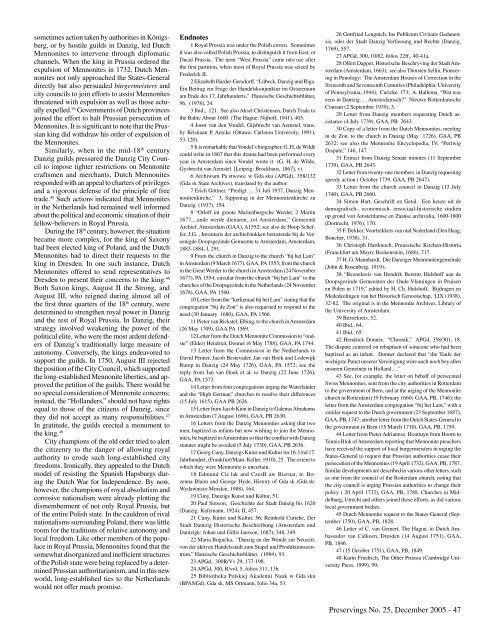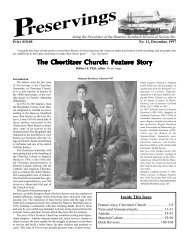Preservings $20 No. 25, December, 2005 - Plett Foundation
Preservings $20 No. 25, December, 2005 - Plett Foundation
Preservings $20 No. 25, December, 2005 - Plett Foundation
Create successful ePaper yourself
Turn your PDF publications into a flip-book with our unique Google optimized e-Paper software.
sometimes action taken by authorities in Königsberg,<br />
or by hostile guilds in Danzig, led Dutch<br />
Mennonites to intervene through diplomatic<br />
channels. When the king in Prussia ordered the<br />
expulsion of Mennonites in 1732, Dutch Mennonites<br />
not only approached the States-General<br />
directly but also persuaded bürgermeisters and<br />
city councils to join efforts to assist Mennonites<br />
threatened with expulsion as well as those actually<br />
expelled. 44 Governments of Dutch provinces<br />
joined the effort to halt Prussian persecution of<br />
Mennonites. It is significant to note that the Prussian<br />
king did withdraw his order of expulsion of<br />
the Mennonites.<br />
Similarly, when in the mid-18 th century<br />
Danzig guilds pressured the Danzig City Council<br />
to impose tighter restrictions on Mennonite<br />
craftsmen and merchants, Dutch Mennonites<br />
responded with an appeal to charters of privileges<br />
and a vigorous defense of the principle of free<br />
trade. 45 Such actions indicated that Mennonites<br />
in the Netherlands had remained well informed<br />
about the political and economic situation of their<br />
fellow-believers in Royal Prussia.<br />
During the 18 th century, however, the situation<br />
became more complex, for the king of Saxony<br />
had been elected king of Poland, and the Dutch<br />
Mennonites had to direct their requests to the<br />
king in Dresden. In one such instance, Dutch<br />
Mennonites offered to send representatives to<br />
Dresden to present their concerns to the king. 46<br />
Both Saxon kings, August II the Strong, and<br />
August III, who reigned during almost all of<br />
the first three quarters of the 18 th century, were<br />
determined to strengthen royal power in Danzig<br />
and the rest of Royal Prussia. In Danzig, their<br />
strategy involved weakening the power of the<br />
political elite, who were the most ardent defenders<br />
of Danzig’s traditionally large measure of<br />
autonomy. Conversely, the kings endeavored to<br />
support the guilds. In 1750, August III rejected<br />
the position of the City Council, which supported<br />
the long-established Mennonite liberties, and approved<br />
the petition of the guilds. There would be<br />
no special consideration of Mennonite concerns;<br />
instead, the “Hollanders,” should not have rights<br />
equal to those of the citizens of Danzig, since<br />
they did not accept as many responsibilities. 47<br />
In gratitude, the guilds erected a monument to<br />
the king. 48<br />
City champions of the old order tried to alert<br />
the citizenry to the danger of allowing royal<br />
authority to erode such long-established city<br />
freedoms. Ironically, they appealed to the Dutch<br />
model of resisting the Spanish Hapsburgs during<br />
the Dutch War for Independence. By now,<br />
however, the champions of royal absolutism and<br />
corrosive nationalism were already plotting the<br />
dismemberment of not only Royal Prussia, but<br />
of the entire Polish state. In the cauldron of rival<br />
nationalisms surrounding Poland, there was little<br />
room for the traditions of relative autonomy and<br />
local freedom. Like other members of the populace<br />
in Royal Prussia, Mennonites found that the<br />
somewhat disorganized and inefficient structures<br />
of the Polish state were being replaced by a determined<br />
Prussian authoritarianism, and in this new<br />
world, long-established ties to the Netherlands<br />
would not offer much promise.<br />
Endnotes<br />
1 Royal Prussia was under the Polish crown. Sometimes<br />
it was also called Polish Prussia, to distinguish it from East, or<br />
Ducal Prussia. The term “West Prussia” came into use after<br />
the first partition, when most of Royal Prussia was seized by<br />
Frederick II.<br />
2 Elizabeth Harder-Gersdorff, “Lübeck, Danzig und Riga.<br />
Ein Beitrag zur Frage der Handelskonjunktur im Ostseeraum<br />
am Ende des 17. Jahrhunderts,” Hansische Geschichtsblätter,<br />
96, (1978), 24.<br />
3 Ibid., 121. See also Aksel Christensen, Dutch Trade to<br />
the Baltic About 1600 (The Hague: Nijhoff, 1941), 405.<br />
4 Joost van den Vondel, Gijsbrecht van Aemstel, trans.<br />
by Kristiaan P. Aercke (Ottawa: Carleton University, 1991),<br />
53-120).<br />
5 It is remarkable that Vondel’s biographer, G. H. de Wilde<br />
could write in 1867 that this drama had been performed every<br />
year in Amsterdam since Vondel wrote it (G. H. de Wilde,<br />
Gysbrecht van Aemstel [Leipzig: Brockhaus, 1867], v).<br />
6 Archiwum Pa stwowe w Gda sku (APGd), 358/132<br />
(Gda sk State Archives), translated by the author.<br />
7 Erich Göttner, “Predigt. . . 31 Juli 1937, Danzig Mennonitenkirche,”<br />
3. Sippentag in der Mennonitenkirche zu<br />
Danzig (1937), 154.<br />
8 “Orloff int groote Marienburgsche Werder, 2 Martin<br />
1677,...ande werde dienaren...tot Amsterdam,” Gemeente<br />
Archief, Amsterdam (GAA), A1552; see also de Hoop Scheffer,<br />
J.G. , Inventaris der archiefstukken berustende bij de Vereenigde<br />
Doopsgezinde Gemeente te Amsterdam, Amsterdam,<br />
1883-1884, I, 291.<br />
9 From the church in Danzig to the church “bij het Lam”<br />
in Amsterdam (9 March 1677), GAA, PA 1553; from the church<br />
in the Great Werder to the church in Amsterdam (24 <strong>No</strong>vember<br />
1677), PA 1554; circular from the church “bij het Lam” to the<br />
churches of the Doopsgezinde in the Netherlands (24 <strong>No</strong>vember<br />
1678), GAA, PA 1560.<br />
10 Letter from the “kerkeraad bij het Lam” stating that the<br />
congregation “bij de Zon” is also requested to respond to the<br />
need (30 January 1680), GAA, PA 1566.<br />
11 Pieter van Rickstel, Elbing, to the church in Amsterdam<br />
(26 May 1709), GAA PA 1569.<br />
12 Letter from the Dutch Mennonite Commission to “oudste”<br />
(Elder) Hendrick Donner (6 May 1788), GAA, PA 1744.<br />
13 Letter from the Commission in the Netherlands to<br />
David Penner, Jacob Bestevader, Jan van Hoek and Lodewijk<br />
Rump in Danzig (24 May 1726), GAA, PA 1572; see the<br />
reply from Jan van Hoek et al. to Danzig (22 June 1726),<br />
GAA, PA 1573.<br />
14 Letter from four congregations urging the Waterlander<br />
and the “High German” churches to resolve their differences<br />
(15 July 1615), GAA PB 2626.<br />
15 Letter from Jacob Kinn in Danzig to Galenus Abrahams<br />
in Amsterdam (7 August 1696), GAA, PB 2630.<br />
16 Letters from the Danzig Mennonites asking that two<br />
men, baptized as infants but now wishing to join the Mennonites,<br />
be baptized in Amsterdam so that the conflict with Danzig<br />
statutes might be avoided (5 July 1730), GAA, PB 2636.<br />
17 Georg Cuny, Danzigs Kunst und Kultur im 16. Und 17.<br />
Jahrhundert, (Frankfurt/Main: Keller, 1910), <strong>25</strong>. The extent to<br />
which they were Mennonite is uncertain.<br />
18 Edmund Cie lak and CzesB aw Biernat, tr. Bozenna<br />
Blaim and George Hyde, History of Gda sk (Gda sk:<br />
Wydawnicto Morskie, 1988), 164.<br />
19 Cuny, Danzigs Kunst und Kultur, 51.<br />
20 Paul Simson, Geschichte der Stadt Danzig bis 1626<br />
(Danzig: Kafemann, 1924), II, 457.<br />
21 Cuny, Kunst und Kultur, 56; Reinhold Curicke, Der<br />
Stadt Dantzig Historische Beschreibung (Amsterdam und<br />
Dantzigk: Johan und Gillis Jansson, 1687), 348, 349.<br />
22 Maria Bogucka, “Danzig an der Wende zur Neuzeit:<br />
von der aktiven Handelsstadt zum Stapel und Produktionszentrum,”<br />
Hansische Geschichtsblätter, (1984), 93.<br />
23 APGd., 300R/Vv 29, 177-198.<br />
24 APGd, 300, R/vol. 5, folios 311, 13b.<br />
<strong>25</strong> Bibliotheka Polskiej Akademii Nauk w Gda sku<br />
(BPANGd), Gda sk, MS Ortmann, folio 34a, 53.<br />
26 Gottfried Lengnich, Ius Publicum Civitatis Gedanensis,<br />
oder der Stadt Danzig Verfassung und Rechte (Danzig,<br />
1769), 557.<br />
27 APGd, 300, 10/82, folios 22ff., 40-41a.<br />
28 Olfert Dapper, Historische Beschryving der Stadt Amsterdam<br />
(Amsterdam, 1663); see also Thorsten Sellin, Pioneering<br />
in Penology: The Amsterdam Houses of Correction in the<br />
Sixteenth and Seventeenth Centuries (Philadelphia: University<br />
of Pennsylvania, 1944); Curicke, 173; A. Hallema, “Wat was<br />
eens in Dantzig. . . Amsterdamsch?” Nieuwe Rotterdamsche<br />
Courant (2 September 1939), 3.<br />
29 Letter from Danzig members requesting Dutch assistance<br />
(4 July 1739), GAA, PB 2643.<br />
30 Copy of a letter from the Dutch Mennonites, meeting<br />
in de Zon, to the church in Danzig (May 1726), GAA, PB<br />
2632; see also the Mennonite Encyclopedia, IV, “Periwig<br />
Dispute,” 146, 147.<br />
31 Extract from Danzig Senate minutes (11 September<br />
1739), GAA, PB 2643.<br />
32 Letter from twenty-one members in Danzig requesting<br />
speedy action ( October 1739, GAA, PB 2647).<br />
33 Letter from the church council in Danzig (13 July<br />
1740), GAA, PB 2660.<br />
34 Simon Hart, Geschrift en Getal. Een keuze uit de<br />
demografisch-, economisch- ensociaal-historische studien<br />
op grond von Amsterdamse en Zaanse archivalia, 1600-1800<br />
(Dortrecht, 1976), 170.<br />
35 F. Dekker, Voortrekkers van oud Nederland (Den Haag,<br />
Boucher, 1938), 31.<br />
36 Christoph Hartknoch, Preussische Kirchen-Historia<br />
(Franckfurt am Mayn: Beckenstein, 1686), 717.<br />
37 H. G. Mannhardt, Die Danziger Mennonitengemeinde<br />
(John & Rosenberg, 1919).<br />
38 “Bezoekreis van Hendrik Berents Hulshoff aan de<br />
Doopsgezinde Gemeenten der Oude Vlamingen in Pruisen<br />
en Polen in 1719,” edited by H. Ch. Hulshoff, Bijdragen en<br />
Mededeelingen van het Historisch Genootschap, LIX (1938),<br />
32-82. The original is in the Mennonite Archives, Library of<br />
the University of Amsterdam.<br />
39 Bezoekreis, 52.<br />
40 Ibid., 64.<br />
41 Ibid., 65.<br />
42 Hendrick Donner, “Chronik,” APGd, 358/301, 18.<br />
The dispute centered on rebaptism of someone who had been<br />
baptized as an infant. Donner declared that “die Taufe der<br />
wichigste Punct unserer Vereinigung wäre auch noch bey allen<br />
unseren Gemeinen in Holland….”<br />
43 See, for example, the letter on behalf of persecuted<br />
Swiss Mennonites, sent from the city authorities in Rotterdam<br />
to the government of Bern, and at the urging of the Mennonite<br />
church in Rotterdam (19 February 1660; GAA, PB, 1746); the<br />
letter from the Amsterdam congregation “bij het Lam,” with a<br />
similar request to the Dutch government (23 September 1687),<br />
GAA, PB, 1747; another letter from the Dutch States-General to<br />
the government in Bern (15 March 1710), GAA, PB, 1759.<br />
44 Letter from Pieter Adriannsz. Houttuyn from Hoorn to<br />
Teunis Blok of Amsterdam reporting that Mennonite preachers<br />
have received the support of local burgermeisters in urging the<br />
States-General to request that Prussian authorities cease their<br />
persecution of the Mennonites (19 April 1732), GAA, PB, 1787.<br />
Similar developments are described in various other letters, such<br />
as one from the council of the Rotterdam church, noting that<br />
the city council is urging Prussian authorities to change their<br />
policy ( 20 April 1732), GAA, PB, 1788. Churches in Middelburg,<br />
Utrecht and others joined these efforts, as did various<br />
local government bodies.<br />
45 Dutch Mennonite request to the States-General (September<br />
1750), GAA, PB, 1828.<br />
46 Letter of C. van Gemert, The Hague, to Dutch Ambassador<br />
van Calkoen, Dresden (14 August 1751), GAA,<br />
PB, 1846.<br />
47 (15 October 1751), GAA, PB, 1849.<br />
48 Karin Friedrich, The Other Prussia (Cambridge University<br />
Press, 1999), 99.<br />
<strong>Preservings</strong> <strong>No</strong>. <strong>25</strong>, <strong>December</strong> <strong>2005</strong> - 47

















